Trip Logs
Antarctica, South Georgia & the Falkland Islands Trip Log: December 22, 2018–January 7, 2019
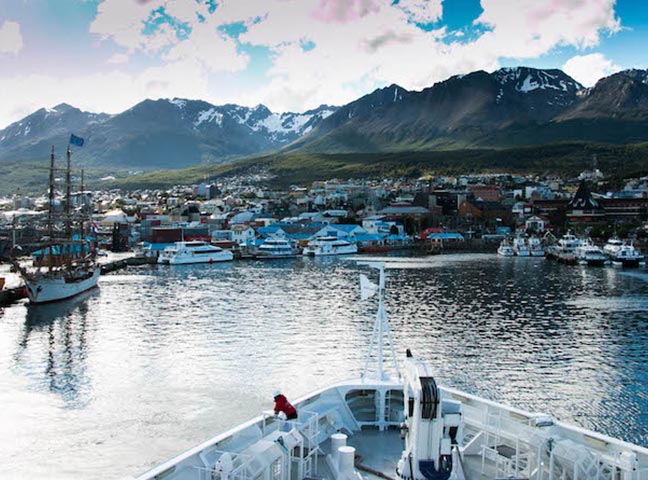
December 23, 2018 | Ushuaia, Argentina
We converged on the small city of Ushuaia, the gateway to Antarctica. Our group had arrived from distant reaches of the planet for the same reason: to experience the wildlife and magnificent landscapes of Antarctica, South Georgia and the Falkland Islands. Clouds parted every so often, revealing striking views of the southern Andes. The glaciers, lakes and soaring peaks had to be seen to be believed, and the mesmerizing scenery seemed to go on forever.
Ushuaia was a growing outpost filled with restaurants and shops catering to travellers with an adventurous spirit. Enjoying the unique distinction as the southernmost town in the world, Ushuaia is locally known as El Fin de Mundo — “The End of the World.” We could hardly imagine a more picturesque setting from which to embark on our luxury Antarctica cruise.
The sky was a mix of sun and clouds, and a brisk wind brushed past our cheeks as we arrived at the pier, which was lined with fishing boats and expedition vessels. Making our way up the gangway, our group was welcomed by the A&K Expedition Team and crew of our beautiful ship, ‘Le Lyrial.’ We settled into our staterooms and familiarized ourselves with the layout before enjoying some welcome Champagne and snacks in the Grand Salon.
Following a lifeboat drill, we gathered in the theater for an introduction to the ship and crew, joining Cruise Director Paul Carter; Expedition Director Suzana Machado D’Oliveira; and Expedition Leader Kara Weller. Each member of the A&K Expedition Team welcomed us aboard and shared some of their background. Almost immediately, it became clear that their passion for Antarctica and desire to share everything they had learned would make the journey truly special.
We were treated to a delicious dinner, and then enjoyed some time on the afterdeck watching Ushuaia vanish into the distance. Darkness fell over magnificent mountains hemming the Beagle Channel on both sides, while small bands of South American terns and blue-eyed shags fished in the waters that teemed with life. Everyone enjoyed one last breath of South American air, along with the fresh smell of greenery sprawled across the mountains. Later that night, we eagerly awaited tomorrow as we drifted off to sleep.
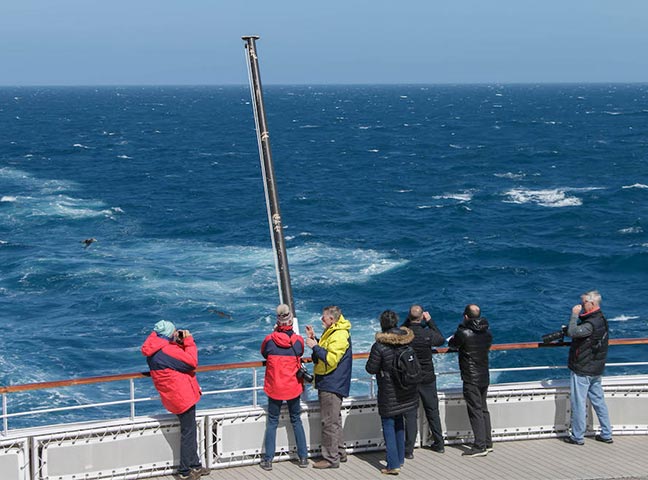
December 24, 2018 | At Sea
We awoke to the ocean rolling in every direction, with South America now far behind us. The sheer number of birds swirling behind the ship was astonishing, their wings locked open and completely still in the strong winds. Many of these creatures were black-browed albatrosses, which breed in the Falkland Islands. In fact, they are the most abundant albatross in the world, and the majority of their total population breeds in the group of islands we would be visiting tomorrow.
Everyone had the opportunity to exchange our parkas for more formfitting replacements before ornithology lecturer Rich Pagen presented “Seabirds: Ambassadors of the Southern Ocean.” He highlighted some of the species we would see out in the open ocean and told stories of their remarkable long-distance travel capabilities. Some species regularly circumnavigate the entire globe between nesting sessions. Sadly, certain predators that have been introduced to remote breeding islands have threatened the survival of many seabirds that call these islands home.
We spent some time on deck admiring the wandering albatrosses and giant petrels circling the ship. Then, everyone gathered in the theater for photo coach Richard Harker’s presentation entitled “Photographing South Georgia and Antarctica: What to Expect and How to Prepare.” A wonderful lecture well suited to novices and professional photographers alike, it covered everything from how best to cope with Antarctica and South Georgia’s challenging light conditions to protecting our camera equipment in unpredictable weather.
After lunch, we enjoyed a book in the Observation Bar before joining geology lecturer Dr. Jason F. Hicks in the theater for “Gondwana: Breaking Plates to Form a Continent.” Jason provided a detailed overview of plate tectonics. We learned that these plates move in different directions very slowly, driven by convection currents generated from intense heat in the Earth’s core. He also leveraged famous hot spots as examples of these powerful forces in action, including the San Andreas fault.
We met the A&K Expedition Team out on deck, picking up a few photography tips from Richard along the way. Then we gathered in the theater for “An Introduction to the Falkland Islands,” which was presented by various members of the A&K Expedition Team.
Donning our finest Sunday attire, we prepared for the Captain’s Welcome Aboard Cocktail Party. The gala was held in the theater, where we mingled over Champagne as the ship swayed softly back and forth. We met Captain Rémi Genevaz, who told us a little about himself and introduced several core members of his crew. Everyone had an amazing time, and the evening was rounded off by a sublime dinner.
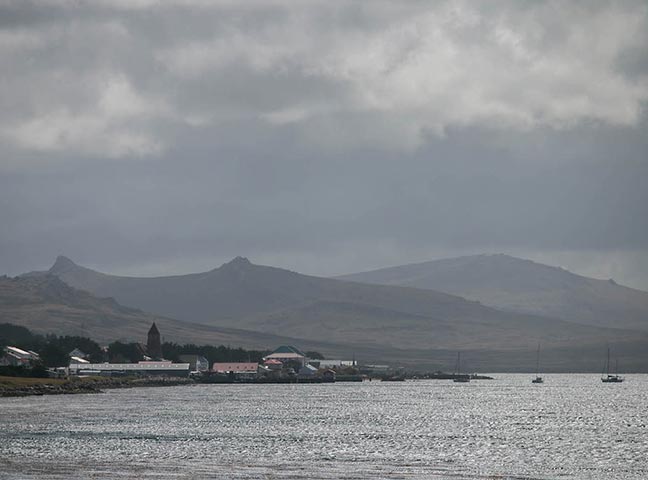
December 25, 2018 | Stanley, Falkland Islands
With scattered clouds peppering the blue skies overhead, ‘Le Lyrial’ sailed past low-lying rocky islets en route to the protected harbor at Stanley. We watched our approach to the Falkland Islands from the outer decks during a hearty breakfast, and made our way down the gangway for a morning of exploration. This windswept archipelago of oceanic heathland is among the few places left on earth that can truly be described as “off the beaten path.” Consisting of over seven hundred small islands, the Falklands provide a unique ecological niche for many breeding birds and marine mammals.
Stanley was founded in 1843, born from a need for a secure and accessible port for those sailing vessels owned by the Royal Navy. However, the chosen site for the anchorage was not universally popular, and was even described in one contemporary reference as “the most miserable boghole” on the island. Nevertheless, Stanley boomed as a port of repair for ships attempting to round Cape Horn during the California Gold Rush of the 1850s. With steam-powered engines propelling the sailing industry into new territory and the Panama Canal reducing sea traffic around Cape Horn, a brief period of commercial whaling saw a demand for woolen textiles. Today, the Falkland Islands’ economy benefits from fisheries and tourism.
There were a multitude of organized tours for us to choose from. The majority headed off to see the gentoo penguins, the first encounter with penguins for some. We watched in awe as these endearing creatures went about their business on a flat grassy area overlooking a windswept sea below.
Others broke off for the Long Island Farm tour, where we learned about the use of peat as an energy source. We even had the opportunity to cut some of the peat ourselves. Most fascinating of all was how relaxed the sheep seemed to be during the shearing process. We also enjoyed talking to the locals, gaining a better appreciation for what life is really like out here in “The Camp.”
During the afternoon, we had the opportunity to explore the old-fashioned town of Stanley on our own. We took in the picturesque houses, with their multicolored tin roofs, open grassy lawns often inhabited by flocks of upland geese, and the cornucopia of gift shops and art galleries that lay scattered along the waterfront and throughout town. It was a charming place to roam around, grab a pint at one of the local watering holes, or sit on a bench atop the green while looking out over the bay.
After a leisurely stroll (or shuttle ride) along the shoreline back to the pier, we boarded the ship and gathered in the Grand Salon to greet Santa Claus, who had landed his sleigh on the upper deck of ‘Le Lyrial’ to wish everyone a merry Christmas. Soon, ‘Le Lyrial’ pulled away from the pier, and made its way east toward South Georgia.
Before dinner, we sang Christmas carols around the piano alongside the A&K Expedition Team, whose voices were some of the best we had ever heard. It was a truly magical Christmas, spent with new friends on what we knew would be a journey of a lifetime.

December 26, 2018 | At Sea
We awoke to the glorious Scotia Sea and a gentle swell, accompanied by a mob of giant petrels. After a delicious breakfast, we met Richard in the theater for “Photographing South Georgia and Antarctica: Mastering Your Camera.” He went in to detail about the features of our modern-day digital cameras, including histograms and exposure compensation — features that would be invaluable out here in South Georgia and Antarctica. Richard did a fantastic job of explaining the technical aspects of photography, which made everyone feel much more confident.
Later in the morning, Captain Genevaz invited us to the bridge to learn about the ship’s instruments. Then Sabina Leader Mense, marine mammal lecturer, presented “An Introduction to Pinnipeds: Southern Ocean Seals and Fur Seals.” We learned all about the enormous elephant seals, with their harems on the beach, along with the ubiquitous fur seals that have recovered from being nearly wiped out by sealers a century earlier. Sabina also spoke about Weddell seals and the holes they carve in the open sea ice during the winter; and leopard seals, whose diet changes from young crabeater seals to krill to penguins during the fall.
Next, history lecturer Rachel Morgan discussed the life and times of British explorer Sir Ernest Shackleton in her presentation entitled “Shackleton: Everybody’s Hero?” She focused particularly on the Imperial Trans-Antarctic Expedition from 1914 to 1917, Shackleton’s daring attempt to make the first land crossing of the Antarctic continent. Instead, the voyage became a riveting tale of courage in the face of overwhelming odds. She told the hair-raising story of how Shackleton and his men found themselves trapped at sea after their ship, ‘Endurance,’ became cemented in by pack ice.
A practical solution to the ice debacle was quickly underway. Men armed with iron bars and heavy makeshift chisels attempted to hammer through the ice, but to no avail. Unable to free their ship from its frozen restraints, the crew rounded up the lifeboats and supplies and hauled them onto a nearby ice floe. They made camp there, hoping the sea current would carry them to civilization. In the grueling year that would follow, Shackleton and his men searched for land using both their lifeboats and ice floes as improvised rafts. After sailing for 800 miles for what surely seemed like an eternity, the crew made their way to Elephant Island and were finally rescued. It was the first time they stood on solid ground in 497 days.
We bundled up and joined the A&K Expedition Team on deck to scout for whales and seabirds. Beneath the water was a profusion of sei and fin whales, while Antarctic prions careened en masse overhead. There must have been a glut of plankton in the water to draw so many whales to our location, and they were certainly taking advantage of the bounty.
Rich presented the final lecture of the day, “Penguins, Prions and Pipits: The Southern Ocean Sanctuary of South Georgia.” He provided an introduction to penguin biology, and went on to describe the fascinating asynchronous breeding cycle of the king penguin. Fasting chicks can lose as much as 68 percent of their body weight over the winter, making the king penguin more resistant to starvation than any other warm-blooded animal. Rich stressed the importance of South Georgia as a breeding site for a wide variety of albatrosses and petrels. He also advised everyone to be on the lookout for the South Georgia pipit, the sole-breeding songbird; and the South Georgia pintail, one of only two waterfowl that regularly occur on the island.
Our first evening recap consisted of a Q&A with Pete Clement, naturalist and Zodiac driver, and a lesson on the ins and outs of smartphone photography with Richard. The Young Explorers shared stories and photos of their visit to the lighthouse and tide pools while in the Falkland Islands.
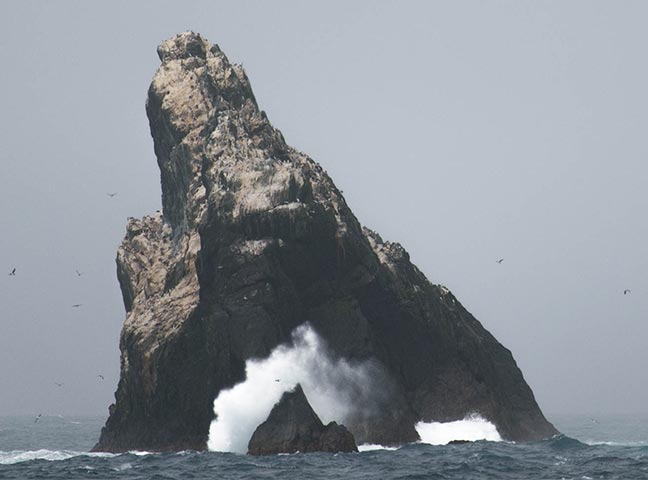
December 27, 2018 | At Sea
We peeled back the curtains in the morning, and discovered the air out on deck to be a bit cooler than last night. We suspected the reason for this was our overnight passing through the Antarctic Convergence. A region of the Southern Ocean that encircles the entire continent, the Antarctic Convergence is a crucial boundary where the cold waters of the Antarctic circumpolar current intermix with warmer waters to the north. This concoction sparks profound weather changes, the beginning of a favorable chain reaction: Nutrient concentrations enjoy a healthy upswing, leading to increased plant life that in turn lead to increased animal life.
Sabina kicked off the day with “An Introduction to Cetaceans: Southern Ocean Whales, Dolphins and Porpoises.” She shared many amazing stories about various mammals, from the far-reaching, low-frequency vocalizations of blue whales to the cooperative bubble-net feeding of humpback whales. Meanwhile, the Young Explorers learned about gyotaku, the traditional Japanese art of printing fish. It was nice to hear that fish had been donated by the Falkland Islands Fisheries Department to help create some beautiful works of art.
After some fresh air out on deck, we gathered back in the theater for a mandatory briefing concerning proper conduct ashore, led by Kara and Suzana. They also covered the ins and outs of the Zodiacs, rubber inflatable boats that would be our transport of choice out here in the great white expanse.
Shag Rocks, a cluster of six rocky pinnacles, had been sighted. The tallest reached an impressive 233 feet above the sea. It wasn’t long before the guano-covered rocks were close enough for us to observe the more than 2,000 pairs of nesting blue-eyed shags, which give the sizable rocks their name. Owing to the waters attracting an array of marine life, we managed to spot several humpback whales, not to mention a curious snowy sheathbill and a pair of gorgeous snow petrels. Observing these two graceful Antarctic birds flying together was amazing, each sporting a coat as white as fresh milk or snow.
Later, we made our way to Deck 3 to comply with new biosecurity measures that were in force on South Georgia. We vacuumed our clothing and even our backpacks to remove any plant seeds accidentally picked up during our trek in the Falkland Islands. We also scrubbed our boots to rid ourselves of any material remaining in the treads. This was to ensure that foreign plants, animals and pathogens would not be introduced to South Georgia.
We joined Rachel in the theater for her lecture “Whaling in the Southern Ocean.” It was rather sobering to learn that the fjords and bays of South Georgia were once home to countless large whales. Today, very few are seen anymore. The most important period in the history of South Georgia was the whaling era from 1904 to the mid-1960s. In 1904, Norwegian explorer Carl Anton Larsen set up the first whaling station in Grytviken. By 1912, a total of 17 companies were whaling in South Georgia, though the shore-based whaling factories were gradually phased out in the 1920s with the advent of the factory whaling ships and open-ocean whaling. The last whaling station at South Georgia closed in 1965.
We spent some time on deck before recap and dinner, admiring the storm petrels dancing on the water’s surface as they flew into the wind.
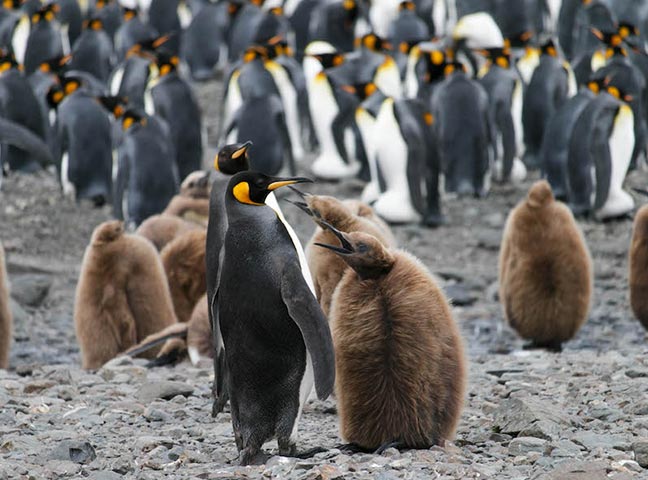
December 28, 2018 | Fortuna Bay & Salisbury Plain
We awoke this morning to calm conditions and stunning mountain scenery on both sides of Fortuna Bay. The raucous calls of fur seals and king penguins echoed in the distance when we walked on deck to have a look around. After breakfast, we boarded the Zodiacs and soon found ourselves ashore at the head of the bay. Here, we began a one-mile hike to a king penguin rookery far up the glacial valley.
We paused to admire elephant seals piled together in the tall tussock grass, their characteristic sneezing and snorting sounds alerting us to their presence. Farther up the outwash plain, king penguins lounged in the stream, partaking in their annual catastrophic molt. As the penguins had begun to shed their coats, the surface of the stream was decorated with thousands of tiny white feathers working their way down to sea.
After arriving at the colony, we observed everything from adults incubating to chicks begging incessantly for food with distinct whistles. Skuas patrolled the skies overhead, waiting for any opportunity to drop in and snatch an egg or a chick. Several waterfalls poured from the towering glaciated peaks above us, and fur seals were everywhere.
Over lunch, we admired the scenery as ‘Le Lyrial’ repositioned to the Bay of Isles. We would go ashore on Salisbury Plain. This large outwash plain is fronted by a broad black-sand beach, and is home to one of South Georgia’s largest king penguin rookeries. American ornithologist Robert Cushman Murphy undertook much of his research here in 1912, and the westernmost glacier in the bay is named for his wife, Grace.
The wind was light and swell minimal, so we sped ashore on the Zodiacs. The A&K Expedition Team was ready for us, steadying our rafts while we disembarked and headed up the beach. Once ashore, our perception of South Georgia changed for the better. It was more beautiful than anything we could have ever imagined. We walked past snoozing fur seals and molting king penguins. And at the edge of the rookery was a cluster of full-grown penguin chicks clad in fuzzy brown wool, awaiting the arrival of food from mom or dad. The weather would habitually shift from sunny skies to wild winds. Still, it was worth it to see such a beautiful and peaceful sanctuary up-close.
After the emperor penguin, the king penguin is the largest of the penguin species. Like its larger cousin, king penguins incubate using their feet instead of building and maintaining a nest. We observed numerous king penguins with their feet tilted up, and a patch of loose skin and blubber draped on top, carefully protecting their egg from both the cold and any predators lurking nearby.
Some of us stumbled upon a group of giant petrels feeding on an adult penguin they had recently killed. With groans and loud cries, they spread their tails and held their wings open. This was their way of showing dominance to the others in their posse so they could claim first dibs on dinner.
Jason kicked off the recap with “South Georgia’s Part in the Volcanic Arc of the Scotia Sea.” Rich helped us practice our penguin calls, where we mimicked the squawking and other eccentric vocalizations produced by both chicks and adults. It was a glorious first day in South Georgia, and we celebrated the day on deck watching the light fade over this magical place.
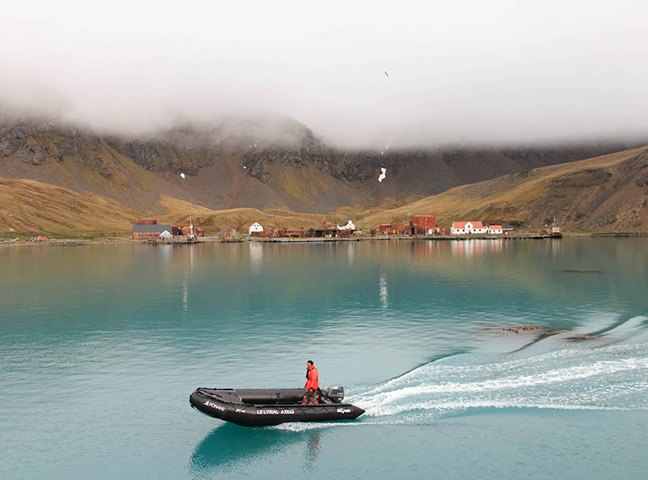
December 29, 2018 | Grytviken & Stromness
Over breakfast, ‘Le Lyrial’ made its way into the calm waters of Cumberland Bay, with South Georgia’s highest peaks looming over us in the distance. Grytviken, a place dating back to the age of Antarctic exploration and exploitation, could be seen just ahead of the ship, tucked away in a quiet cove. The most important period in the history of Grytviken and South Georgia was its whaling era, and evidence of the former whaling operation remained.
We landed on a beach just below Grytviken Cemetery. It was here that the grave of Shackleton himself could be found, along with those of many whalers who lost their lives in the pursuit of whale oil. Shackleton died of a heart attack in Cumberland Bay in 1922, just six years after rescuing his crew from the doomed ‘Endurance.’ While Shackleton’s body was en route to England, a telegram was received from his wife, Emily, insisting that he be laid to rest in Grytviken Cemetery. Interestingly, the ashes of Frank Wild — leader of the party from Shackleton’s shipwrecked expedition — had been interred there just a few years prior, and the two gravesites lay beside one another to this day.
We wandered past more fur seals and elephant seals en route to what remained of the whaling station. Rusted storage tanks, ramshackle whale catchers and old industrial machinery lay in disarray. Built in 1913, the Whalers Church officiated a few marriages and baptisms. However, because life in Grytviken was harsh, funerals were more common. The remains of an old ski jump, used by whalers during their limited free time, could be seen on the mountainside just above the church.
The South Georgia Museum was a must-see, and we worked our way through the various rooms with their remarkable records and natural history displays. We also stopped by the shop to browse a myriad of attractive souvenirs. Basking in the sun, many draped themselves over the benches in front of the museum while others returned to the ship for a lecture by Sarah Lurcock from the South Georgia Heritage Trust. Sarah spoke about habitat restoration, and we learned that reindeer and rats once introduced to the island have been eradicated.
We went ashore just down the beach from the dilapidated Stromness whaling station. Unlike Grytviken, the station had not been restored or even maintained; having been abandoned not long after whaling ceased here back in 1931, the building remained the same as it was all those years ago. The main draw of the landing was to walk to the head of the glacial valley. Here at the waterfall, Shackleton, Frank Worsley and Tom Crean had descended on foot following their miraculous journey from Elephant Island.
We passed fur seals and king penguins as we headed up the braided stream and its gravel bed. Above us, Antarctic terns flew en route to the sea. Returning from the water, gentoos marched toward the low hills near one of the valleys. We were struck by how far they had travelled from their nesting site. At recap, Rachel talked about the role South Georgia played in Shackleton’s life, and Sabina hosted a sort of game show with a fur seal and elephant seal theme. Daylight faded as we sailed east toward Gold Harbour. It was an incredible day, and we headed off to bed early so we would be prepared to see more of South Georgia tomorrow.
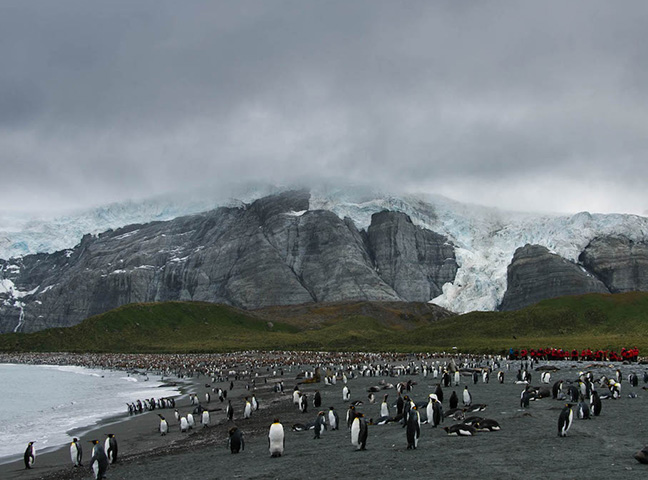
December 30, 2018 | Gold Harbour & Cooper Bay
The gray sky brightened in the morning. Relaxing over breakfast, we enjoyed fresh coffee and buttery croissants. It wasn’t long before the Zodiacs were lowered into the water, and we found ourselves stepping ashore at Gold Harbour, one of the most beautiful beaches in South Georgia. Gold Harbour is said to be named for the glittering seams of iron pyrite — a brassy, yellow mineral known as fool’s gold — that are found in the cliffs. We worked our way up from the landing site, carefully maneuvering around a huge gathering of elephant seals.
The air was filled with a symphony of calls, including loud snorts and belches regularly emanating from countless young male elephant seals sparring with one another on the beach and in the shallows. A few of them even approached our group, travelling much like an inchworm.
Farther down the beach was the king penguin colony, with groups of fluffy wool-coated chicks scattered around the edge of the rookery. These juvenile king penguins are sometimes referred to as “oakum boys” — named by early whalers because of the resemblance the brown plumage has to the color of oakum, a tarred cotton fiber used for caulking wooden ships.
With so much scenery to absorb, conversation this morning was minimal. We could see huge mountains everywhere, along with the tumbling Bertrab Glacier. Brown skuas soared overhead and rested along the beach, always scouting for their next meal. Meanwhile, giant petrels loafed on the sand with their bills tucked carefully under their back feathers.
Over lunch, Captain Genevaz steered the ship south along the coast to Cooper Bay, one mile northwest of Cooper Island near the entrance to Drygalski Fjord. Discovered by English explorer James Cook in 1775, Cooper Island was named for Robert Palliser Cooper, an officer aboard ‘Resolution’ — a modified warship purchased by the British Royal Navy.
We set out on a Zodiac tour of the area, weaving in and out of the kelp and the fingerlike coves. Snowy sheathbills picked through the algae-covered intertidal zone for food while the occasional South Georgia pipit flew over our heads to get a good look at us. The sandy beaches were littered with male fur seals defending their harems, as well as clusters of elephant seals, their musty odor unmistakable even from a distance. While pairs of light-mantled albatrosses took to the skies, we admired the macaroni penguin colony, with its steep penguin highway leading several hundred feet down to the sea.
Back on board, we admired humpback whales and huge flocks of black-browed albatrosses flying alongside the ship as we made our way southwest around Cape Disappointment, the southern tip of South Georgia. Dennis Mense, naturalist and Zodiac driver, read a poem written by English explorer Apsley Cherry-Garrard. We also heard from Rich regarding his “interview” with a giant king penguin. Following the lecture program, our group shared stories of our experiences in this remote part of the world over dinner.
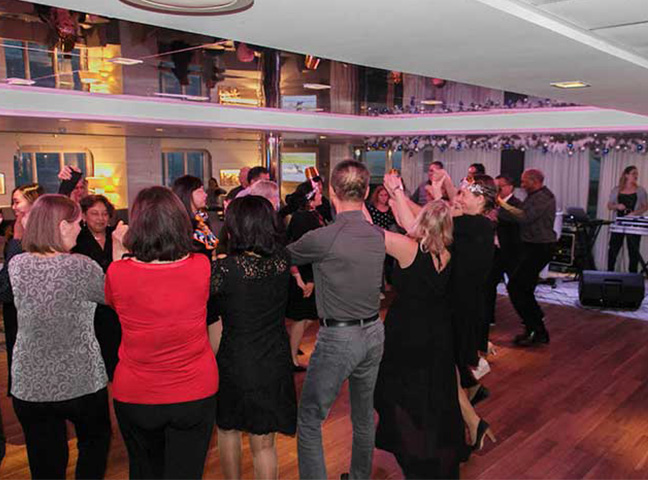
December 31, 2018 | At Sea
Everyone awoke refreshed for a relaxing and educational day at sea, having been rocked asleep from the light swell the night before. We enjoyed a leisurely breakfast, and then met Sabina in the theater for her talk entitled “The Evolution of Marine Mammals.” It was fascinating to learn that whales and dolphins all came from a single hippo-like ancestor, which abandoned the freshwater swamps and river deltas before taking to the seas. Seals have a similar history, having evolved from a carnivorous species that at some point re-entered the water.
Around midmorning, Captain Genevaz took the Young Explorers on a tour of the bridge. He showed them all of the equipment, from the radar and sonar technology used to detect icebergs miles away to the stabilizers used to counter rolling pressure generated by turbulent waters. We were especially grateful for the stabilizers, as without such technology, our smooth and comfortable voyage would not be possible. Those of us that accompanied the naturalists on deck were rewarded with incredible views of wandering albatrosses and an entourage of giant petrels following the ship south.
Jason presented “Future Plate Movements” and discussed what the future of the planet is expected to look like based on present tectonic plate movements. Russ Manning, naturalist and Zodiac driver, came next with “A Year in Antarctica,” sharing stories of his experiences as a base commander on Signy Island. The lecture provided a fascinating glimpse of what life was like at an Antarctic research station. From witnessing the arrival of Adélie penguins on the same day every year to rappelling down a crevasse and exploring the bowels of a glacier, this extraordinary man had done it all.
In the afternoon, we watched from the pool deck as Cape petrels swooped around the ship. Then we went inside to nibble on the holiday cookies the Young Explorers were making. Rachel presented “Scott and Amundsen: A Race to Antarctica.” We learned about Roald Amundsen, the great Nordic explorer who beat British Royal Navy Officer Robert Falcon Scott to the South Pole. Comparing the different strategies each man employed to reach the pole, she shared what was really a heartbreaking tale of human endurance.
During recap, Helen Ahern, naturalist and Zodiac driver, talked about the flowery kelp we saw at Cooper Bay, and Juan José (JJ) Apestegui, Assistant Expedition Leader, shed light on how Scott and Amundsen felt about having to live off of penguin and seal meat for as long as they did. Following a special New Year’s Eve dinner, we mingled over Champagne in one of the ship’s bars, awaiting the climactic stroke of midnight. At last, the countdown began, and we celebrated a New Year’s Eve no one would ever forget.
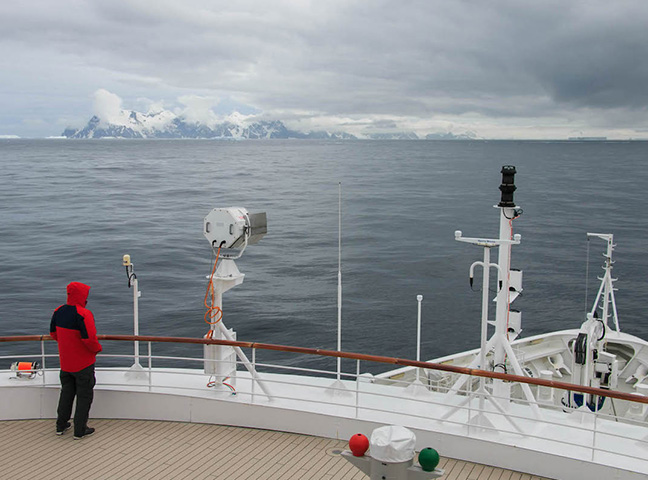
January 1, 2019 | At Sea
Kara’s forecast from last night had come to pass, and we awoke to calm seas. Steel-gray skies and frigid air invoked an almost ghostly atmosphere, and the scenery was eerily beautiful.
Out on deck, we sipped coffee before gathering in the theater for Jason’s lecture entitled “Antarctic Ice: From Icecap to Growler.” He provided a fascinating point of view: Glaciers are actually rivers of ice, flowing (however slowly) down the path of least resistance. Along their journey, glaciers carve up the landscape beneath them, spawning debris similar to how a bulldozer would. We also learned that Antarctica’s massive ice fields can get up to two miles wide, towering above sea level by as much as 12,000 feet.
Next, Rich presented “Black and White and Guano All Over: Antarctic Penguin Colonies and Their Patrollers.” Having spent so much time observing king penguins in South Georgia, we found it fascinating to learn that the brush-tail penguins actually build nests, lay two eggs and complete the entire breeding cycle in a single summer. Rich introduced us to the opportunistic penguin colony patrollers, which take advantage of the seasonal gatherings of penguins to eke out a living in this challenging environment. After the lecture, we stepped outside to join the A&K Expedition Team. Some scanned for more whales and seabirds while others asked Richard about their cameras. Following a tasty lunch, Richard presented “The Perfect Penguin: Using Composition to Turn Snapshots into Art.” During his talk, Richard discussed some of the challenges of photographing wildlife in Antarctica’s ever-changing light conditions, and offered ideas for how we might approach these challenges.
During the afternoon, ‘Le Lyrial’ drew closer to the infamous Point Wild on Elephant Island, named for Frank Wild. We were in awe of how small of an area it was, backed by steep mountains and snow slopes and now completely overrun by nesting chinstrap penguins.
From there, we headed over to a massive tabular iceberg that was wedged between nearby Clarence Island and Cornwallis Island. This bit of broken-off ice shelf stretched across the horizon, and we could not even begin to appreciate the size of this flat-topped chunk of ice, which broke off one of Antarctica’s ice shelves in 1987.
Later, Sabina presented “These Are a Few of My Favorite Whales: Beaked Whales and Killer Whales.” After the lecture, we spent time on deck admiring the impressive mountains amid the far northeast South Shetland Islands — our first look at Antarctica.
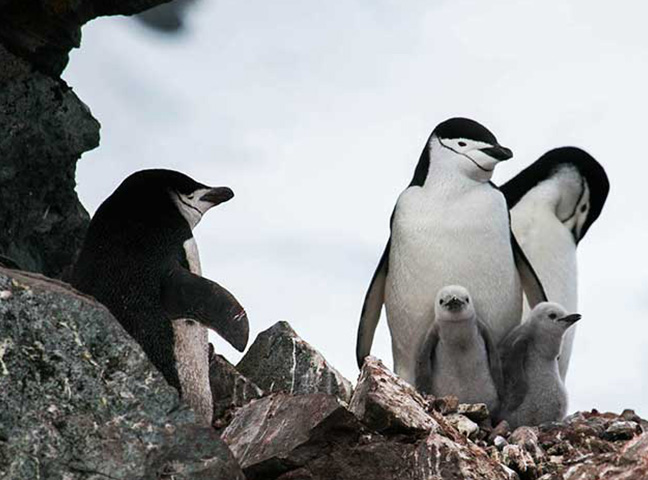
January 2, 2019 | Half Moon Island & Deception Island
‘Le Lyrial’ entered beautiful Moon Bay during the early morning hours. The ice-covered mountains of Livingston and Greenwich islands wrapped almost completely around the bay. Captain Genevaz dropped anchor at Half Moon Island, and the Zodiacs landed in calm conditions on a cobblestone beach with several chinstraps in attendance to greet us. The decaying remains of an old wooden boat lay slightly above the shoreline, and Base Camara — an Argentine Antarctic base and scientific research station painted with bright orange colors — could be seen in the distance on the southwest side of the island.
We ascended the hill to the chinstrap penguin colony, and got a good look at the nesting kelp gulls with their fuzzy tan chicks. Antarctic terns cruised the shallows hunting for small fish, and made a point of harassing any skuas that came anywhere near their nesting area. We made our way down the beach in the other direction, where a bunch of Weddell seals were loafing on the cobblestones.
At the colony, the chinstraps perched upon their stone nests, most of them keeping careful watch over their two gray chicks. The majority of the chicks were about a week old, and split their time between begging for regurgitated krill and tucking their heads into their parent’s brood patch for a nap. Our group witnessed the hysterical vocalizations of the adults once their partners returned from the sea. We also heard the high-pitched whistles from the tiny chicks.
We left the chinstraps to their own devices and headed back to the ship, where we kept our eyes glued to the magnificent scenery outside. After lunch, we lined the railings, watching the ship enter Neptune’s Bellows as we steamed toward the center of Deception Island. The sun glistened on the sea surface as the Captain maneuvered ‘Le Lyrial’ through the narrow passage. Deception Island is so-named because — and while it appears to be a normal island at first glance — it is actually the flooded caldera of a volcano. It is shaped like a doughnut with a bite taken out of its side, and with the right crew behind the controls, it’s possible to sail a ship inside the volcano itself.
Deception Island enjoys a fascinating history. Once a safe harbor for sealers during the 1800s, it conducts extensive geological research today. We landed in Telefon Bay, and hiked inland for a look at a parasitic volcanic crater. The impressive glacier at the back was covered in ash from last century’s volcanic eruptions. And the views from the top across Port Foster were incredible. After we returned to ‘Le Lyrial’ and the last of our Zodiacs were craned back on board, we gathered for recap. We learned about Half Moon Island’s massive blue whale jawbone from Sabine, and a gigantic tabular iceberg from JJ. The mountainous spine of the Antarctic Peninsula glowed yellow off the port side of the ship as we retired to our cabins.

January 3, 2019 | Cuverville Island & Paradise Bay
We awoke to glorious scenery in the Gerlache Strait, with snowcapped peaks scintillating beneath the sun. The cool morning air expedited the wake-up process, and we soon found ourselves cruising ashore on a Zodiac bound for Cuverville Island. This bell curve-shaped island was discovered by Adrien de Gerlache during the Belgian Antarctic Expedition and named for Vice Adm. J.M.A. Cavelier de Cuverville of the French Navy. With steep slopes sprawling with moss and lichen, the island remains one of the greenest places on the continent.
The gentoos on Cuverville Island have received many visitors over the years, so the nearly six thousand breeding pairs tend to be calm and welcoming. We observed their behavior closely. Like clockwork, the penguins continued to add stones to their rock piles while attempting to steal stones from the nests of their rivals. While this hilarious display was taking place, skuas surveyed the ground from above, plotting to use the commotion as an opportunity to snatch a scrumptious egg.
Russ led a hike up to a high vantage point for a sweeping view of the sea, one scattered with sparkling glaciers and icebergs. Traversing the steep snow-covered slope proved to be a challenge. On the bright side, the cool wind felt soothing against our skin. During the descent, we went sliding down the snow slope. It was so much fun that many of us walked all the way back up just to do it again.
Over lunch, ‘Le Lyrial’ passed through the scenic Errera Channel en route to our planned afternoon stop in Paradise Bay. The scenery was spectacular, and we spent plenty of time out on deck taking it in and scouting for wildlife. We went ashore at Brown Station, an Argentine outpost that was currently unstaffed. Gentoos welcomed us as we passed between the orange-colored buildings, and hiked up a steep snow slope for a sweeping view over the bay.
A Zodiac ride in the bay revealed nesting blue-eyed shags with nearly full-grown chicks, which begged for food from their parents with lovable enthusiasm. Antarctic terns and Cape petrels nested on the ledges, and the cliffs hosted tufts of Antarctic hair grass, one of only two flowering plants in the Antarctic. We explored the grounded icebergs near the station, and stopped at a bar boat for a surprise Champagne toast to celebrate the day’s landing in Antarctica.
Our recap was a lively affair. Rich entertained everyone with stories about thieving gentoos, and Dennis read headlights from the poem “The Rime of the Ancient Mariners.” Written by English poet Samuel Taylor Coleridge, the poem relates the experiences of a sailor who has returned from a long voyage at sea.
Over dinner, we admired the scenery as the Captain took the ship closer to the renowned Lemaire Channel — a seven-milelong, one-mile-wide passage between Booth Island and mainland Antarctica. Flanked by towering snow-covered mountains, the channel is nicknamed “Kodak Alley” and remains a must for any visit to the Antarctic Peninsula. Later, on deck with drink in hand, we anxiously looked on as the bridge crew maneuvered ‘Le Lyrial’ through the icy channel.
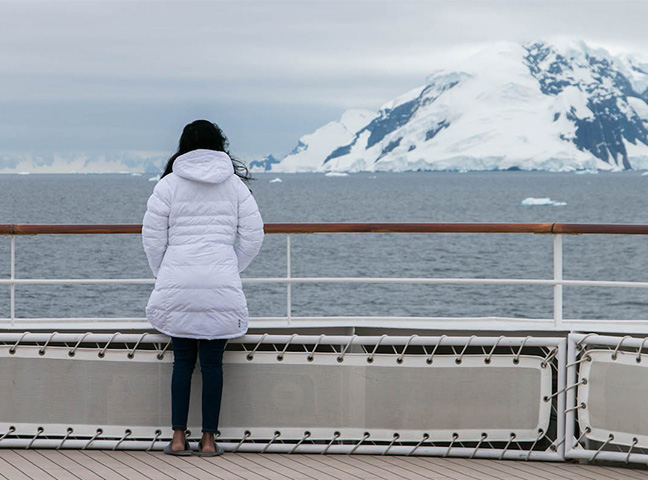
January 4, 2019 | Bransfield Strait & King George Island
We awoke this morning to an announcement from Suzana. Due to a medical evacuation, we would head north to the South Shetland Islands. We lingered at breakfast, gazing upon the spellbinding scenery, then gathered for the first enrichment lecture of the day.
Rich presented “Albatrosses off the Hook: Seabird Conservation and Fisheries in the Southern Ocean.” He discussed the issue of by-catch — specifically, the accidental capture of albatrosses and petrels along the Southern Ocean branch lines, and when Patagonian toothfish are the intended target. Rich also brought to light the declining population trends for several species of seabirds, and went on to explain some of the techniques being used on fishing boats to prevent seabirds from drowning on fishing hooks.
We enjoyed time on deck admiring the giant petrels, along with folding origami penguins in the Grand Salon. After, Rachel presented “21 Years in the Antarctic.” She shared her personal experiences living and working in incredibly remote areas, and we could tell that the quiet continent holds a special place in her heart. When she finished, we realized there was so much more to see and experience on this remarkable frontier. And we couldn’t wait to see for ourselves.
Richard kicked off the day with “In the Footsteps of Ansel Adams: Processing Like the Masters.” Focusing on the importance of following through after capturing an image, he offered many suggestions about how best to adjust them. We left feeling empowered, armed with new and exciting techniques.
During recap, Russ introduced us to the history of the Zodiac while Richard and Paul each discussed the pros and cons of Photoshopping. Everyone enjoyed a delicious dinner, and after, we sped ashore on King George Island in a blizzard. Here, we wandered through the Eduardo Frei Station, a Chilean research base; Russian Bellingshausen Station; and the only permanently staffed Orthodox Church in the world. The weather was atmospheric, and the unearthly landscape could only be described as resembling the surface of the moon.
Bellingshausen Station is named for 19th-century Russian Antarctic explorer Fabian von Bellingshausen, and was once a major fuel depot for the Soviet Antarctic fishing fleet. On January 21, 2014, American tattoo artist Lyle Tuttle became the first person to tattoo on all seven continents after penning his autograph on project assistant Anna Felicity Friedman. Tuttle had set up shop at a scientist’s guest house in Bellingshausen Station, fulfilling a longstanding milestone.
To our great shock, there was news from the station of an attempted murder — the first ever on the frozen continent. Reportedly, a Russian scientist had stabbed a colleague with a kitchen knife because the victim was giving away the endings to various books. With daylight dwindling, and though the wind was letting up a bit, we returned to ‘Le Lyrial’ by Zodiac. Once aboard, everyone gathered in the Grand Salon for a cocktail to celebrate our final day in Antarctica.

January 5, 2019 | At Sea
We awoke this morning to the Southern Ocean at its best (or worst, depending on your perspective). From the Observation Bar, we could see the occasional wave crash over the ship’s bow and spray onto the windows and deck right before our eyes. The forecast predicted that the seas would subside later in the day. For now, we would enjoy the rough-and-tumble conditions occurring outside.
Jason presented “Climate Change: Ancient Record, Modern Reality.” He dived in to research and models predicting temperature change and rising sea levels around the globe, and explained some of the consequences these changes will bring. He also talked about the various steps taken regarding energy production, and how these small changes can make a monumental difference for our planet.
Rich followed with “Sex on and off the Beach: Reproduction and Raising Young in the Aquatic Realm.” He shared fascinating stories from the sea, from the curious male anglerfish that attach themselves to their giant female counterparts for life to the droning hum of the midshipman, a strange toadfish with light-emitting organs used to attract prey. Rich even shared an intriguing bit of trivia: The midshipman gets its name from the photophores that are said to resemble the buttons on a naval officer’s uniform. Everyone left the presentation in awe of the complex lifestyles exhibited by marine life.
After lunch, a nap was positively in order, so we were well rested for Sabina’s talk entitled “Antarctic Benthic Community: Life Below the Surface of Antarctic Waters.” Joined by special guests Jacqueline Fogel and Bowen Brock from the Young Explorers Guides, Sabina took us through the fascinating and diverse community of invertebrates that make their home in the calm and clear waters beneath the sea. From brittle stars to the flattened crustaceans known as isopods, it was fascinating to learn more about this diverse world hidden beneath the Southern Ocean.
In the evening and during much calmer seas, we gathered in the theater for the Captain’s Farewell Cocktail Party. Our group mingled over Champagne and were introduced to many members of the crew. It was a wonderful opportunity to meet all the amazing people who contributed so much to our incredible voyage, and the stage was soon overflowing with roving bodies. Captain Genevaz came to the stage to welcome everyone to the party. He also thanked our group for sailing alongside him, and provided a summary of the highlights. A beautiful dinner was served. Then we enjoyed a cocktail with the new friends we had made, sharing our experiences together throughout the night.
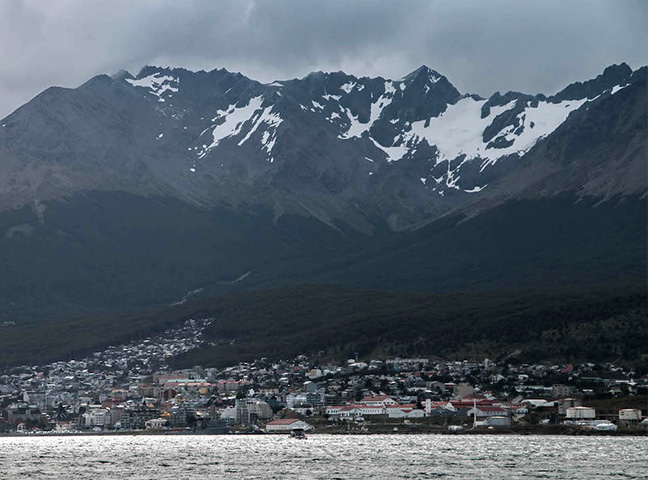
January 6, 2019 | Ushuaia, Argentina
Early this morning, the lumpy seas we had been experiencing began to wane. Cape Horn and southern Tierra del Fuego provided some shelter from the strong winds and large swells. An occasional black-browed albatross made a close pass by the ship, investigating the curious and colossal object plying its way north toward Ushuaia. Out on deck, the Young Explorers and other wildlife watchers were rewarded with spectacular views of a pod of rare hourglass dolphins leaping out of the water beside the ship.
After breakfast, Jason presented “Meteorites in Antarctica” and told us about some of the remarkable finds uncovered at the bottom of the world. Meteorite impacts are not uncommon, but the majority of these space rocks burn up in our atmosphere. However, up to 84,000 meteorites larger than a marble manage to slip through the cracks every year. While Antarctica is the best place to find these elusive fragments, searching for them remains a daunting task. Scientists have to ensure their technology can withstand the extreme temperatures of the continent, and iron meteorites warmed by the sun melt nearby ice, causing them to sink.
Paul gave a disembarkation briefing, where we received our travel information for the journey home. He also presented a DVD film of our journey, produced by the ship’s photo crew. Many got a head start on packing, while others put it off a bit longer in exchange for a nap or time on deck to watch our passage through the Beagle Channel.
We admired the mountain scenery of Tierra del Fuego over lunch, then joined the A&K Expedition Team for an overview of our Antarctica cruise. In the theater, we viewed a captivating slide show made up of photos of our experiences. The photos had been taken by the team, and the presentation had been compiled by Richard “Blackjack” Escanilla, naturalist and Zodiac driver.
The slide show featured photos of our landings, and many recognized themselves disguised behind dark sunglasses and bright-red parkas. The photos were awe-inspiring, and our experiences in Antarctica were so profound they already felt like distant memories.
As ‘Le Lyrial’ docked at the pier in Ushuaia, it was almost shocking to see civilization for the first time in more than a week. We had been away in an icy wilderness for so long that our senses felt heightened — the town seemed more spirited, the smell of the greenery sweeter and more robust. We had reached the end of our extraordinary journey. The final days of the expedition were dominated by reflection and celebration. Antarctica is a place truly beyond description, a remote gem uniquely powerful and fragile in the same breathtaking moment. With all that we had been through, our group would return home with a deeper appreciation for the continent, a place worthy of protecting for generations and generations to come.
 The Americas
The Americas Europe, Middle East and Africa
Europe, Middle East and Africa Australia, NZ and Asia
Australia, NZ and Asia




























































































































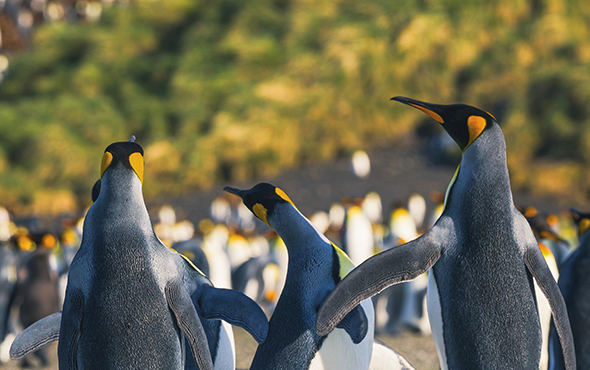
 The Americas
The Americas
 Europe, Middle East and Africa
Europe, Middle East and Africa Australia, NZ and Asia
Australia, NZ and Asia